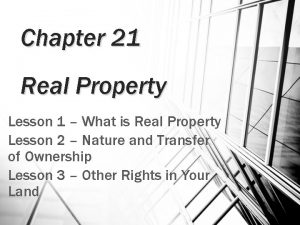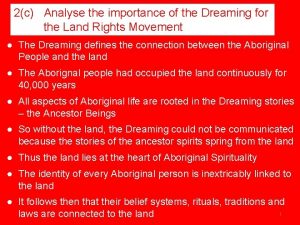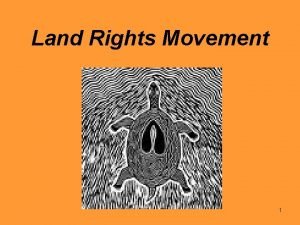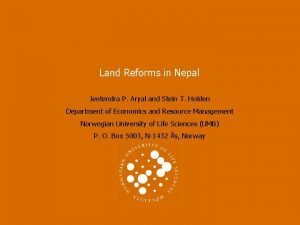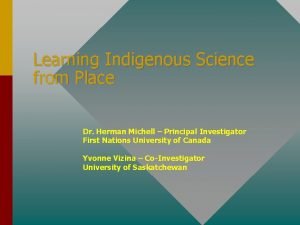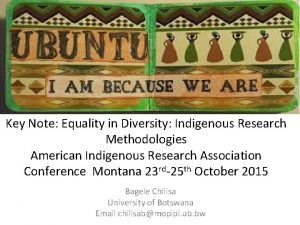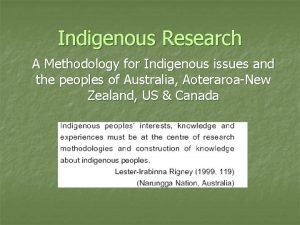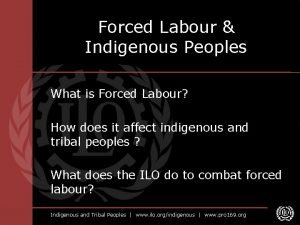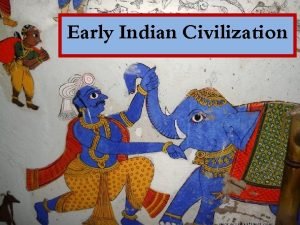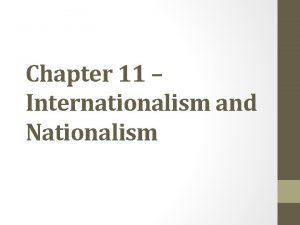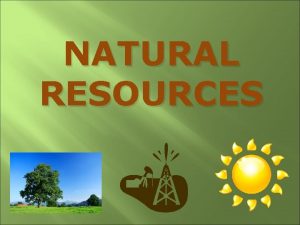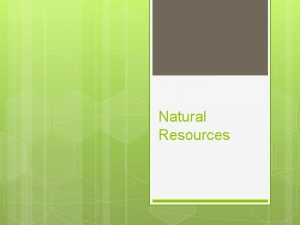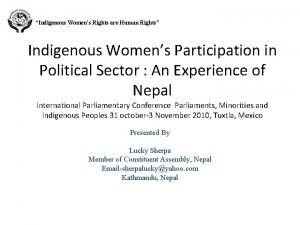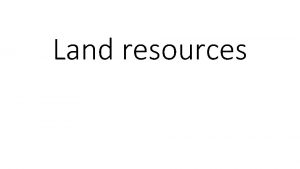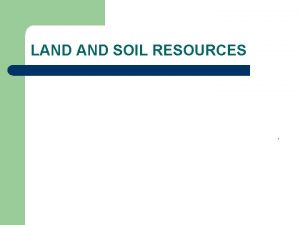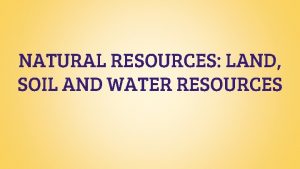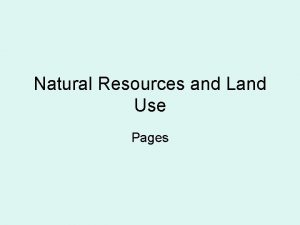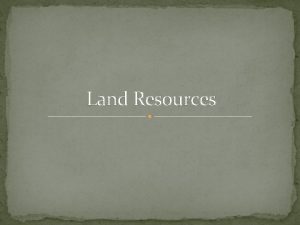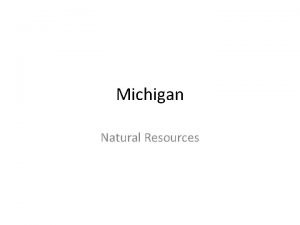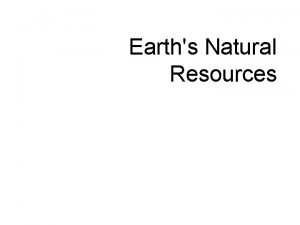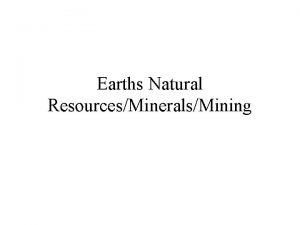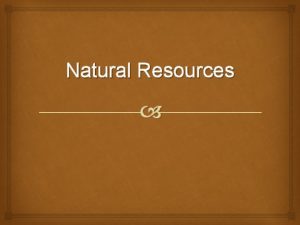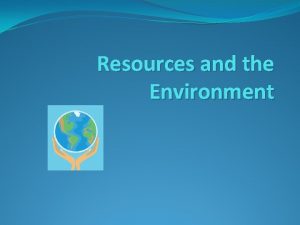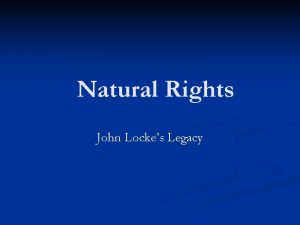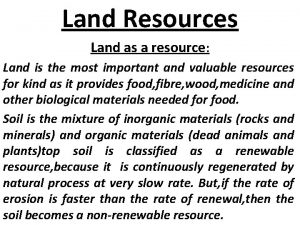Rights to land natural resources as indigenous rights




















- Slides: 20

Rights to land natural resources as indigenous rights? Business and Natural Resources Rights

Indigenous peoples No official (universal) definition of indigenous peoples. However, certain key elements may be identified: Self-identification as indigenous at the individual and community level Historical continuity with pre-colonial and/or pre-settler societies Strong link to territories and surrounding natural resources Distinct language, culture and beliefs

International Labour Organisation Indigenous and Tribal Populations Convention and Recommendation (1957) Article 1(1) This Convention applies to (a) members of tribal or semi-tribal populations in independent countries whose social and economic conditions are at a less advanced stage than the stage reached by the other sections of the national community, and whose status is regulated wholly or partially by their own customs or traditions or by special laws or regulations; (b) members of tribal or semi-tribal populations in independent countries which are regarded as indigenous on account of their descent from the populations which inhabited the country, or a geographical region to which the country belongs, at the time of conquest or colonisation and which, irrespective of their legal status, live more in conformity with the social, economic and cultural institutions of that time than with the institutions of the nation to which they belong.

International Labour Organisation Indigenous and Tribal Peoples Convention (1989) Article 1 1. This Convention applies to: (a) tribal peoples in independent countries whose social, cultural and economic conditions distinguish them from other sections of the national community, and whose status is regulated wholly or partially by their own customs or traditions or by special laws or regulations; (b) peoples in independent countries who are regarded as indigenous on account of their descent from the populations which inhabited the country, or a geographical region to which the country belongs, at the time of conquest or colonisation or the establishment of present state boundaries and who, irrespective of their legal status, retain some or all of their own social, economic, cultural and political institutions.

International Labour Organisation Indigenous and Tribal Peoples Convention (1989) Article 2 Self-identification as indigenous or tribal shall be regarded as a fundamental criterion for determining the groups to which the provisions of this Convention apply.

Indigenous peoples’ (IP) rights to the lands, territories and resources that they have traditionally occupied, owned or used have been recognised by both the ILO Convention 169 and the UNDRIP, emphasising the existing link between IP and land/resources.

ILO Convention 169 Article 13 1. In applying the provisions of this Part of the Convention governments shall respect the special importance for the cultures and spiritual values of the peoples concerned of their relationship with the lands or territories, or both as applicable, which they occupy or otherwise use, and in particular the collective aspects of this relationship. 2. The use of the term lands in Articles 15 and 16 shall include the concept of territories, which covers the total environment of the areas which the peoples concerned occupy or otherwise use.

ILO Convention 169 Article 14 1. The rights of ownership and possession of the peoples concerned over the lands which they traditionally occupy shall be recognised. In addition, measures shall be taken in appropriate cases to safeguard the right of the peoples concerned to use lands not exclusively occupied by them, but to which they have traditionally had access for their subsistence and traditional activities. Particular attention shall be paid to the situation of nomadic peoples and shifting cultivators in this respect. 2. Governments shall take steps as necessary to identify the lands which the peoples concerned traditionally occupy, and to guarantee effective protection of their rights of ownership and possession. 3. Adequate procedures shall be established within the national legal system to resolve land claims by the peoples concerned.

ILO Convention 169 Article 15 1. The rights of the peoples concerned to the natural resources pertaining to their lands shall be specially safeguarded. These rights include the right of these peoples to participate in the use, management and conservation of these resources. <…> Article 16 1. Subject to the following paragraphs of this Article, the peoples concerned shall not be removed from the lands which they occupy.

UNDRIP Preamble Recognizing the urgent need to respect and promote the inherent rights of indigenous peoples which derive from their political, economic and social structures and from their cultures, spiritual traditions, histories and philosophies, especially their rights to their lands, territories and resources,

UNDRIP Preamble Recognizing the urgent need to respect and promote the inherent rights of indigenous peoples which derive from their political, economic and social structures and from their cultures, spiritual traditions, histories and philosophies, especially their rights to their lands, territories and resources,

UNDRIP Article 10 Indigenous peoples shall not be forcibly removed from their lands or territories. No relocation shall take place without the free, prior and informed consent of the indigenous peoples concerned and after agreement on just and fair compensation and, where possible, with the option of return.

UNDRIP Article 26 1. Indigenous peoples have the right to the lands, territories and resources which they have traditionally owned, occupied or otherwise used or acquired. 2. Indigenous peoples have the right to own, use, develop and control the lands, territories and resources that they possess by reason of traditional ownership or other traditional occupation or use, as well as those which they have otherwise acquired. 3. States shall give legal recognition and protection to these lands, territories and resources. Such recognition shall be conducted with due respect to the customs, traditions and land tenure systems of the indigenous peoples concerned.

UNDRIP Article 29 1. Indigenous peoples have the right to the conservation and protection of the environment and the productive capacity of their lands or territories and resources. States shall establish and implement assistance programmes for indigenous peoples for such conservation and protection, without discrimination. 2. States shall take effective measures to ensure that no storage or disposal of hazardous materials shall take place in the lands or territories of indigenous peoples without their free, prior and informed consent. 3. States shall also take effective measures to ensure, as needed, that programmes for monitoring, maintaining and restoring the health of indigenous peoples, as developed and implemented by the peoples affected by such materials, are duly implemented. recall rights to health, clean environment, etc. discussed previously

Questions for discussion • What can be done to promote the rights of the IPs (and governements’ compliance with their legal obligations)? Which enforcement methods can you think of? • What should be the role of non-governmental organisations in this issue? • Evaluate the formulations ‘due respect’, ‘just and fair compensation’, etc. Do you see any potential risks or difficulties? • What would you consider to be the most appropriate forum for the dialogue among parties concerned?

They have access to the broader territory, encompassing the total environments of the areas which they occupy or otherwise use, inclusive of natural resources, rivers, lakes, and coasts. IPs do not have rights only to the land they directly cultivate or inhabit

Collective nature of rights IPs’ land rights comprise both individual and collective aspects. Their rights to lands, territories, and resources are linked to their collective rights to self-determination, non-discrimination, cultural integrity, etc.

Access to natural resources Indigenous and Tribal Peoples' Rights in Practice: A guide to ILO Convention No. 169 (2009): “…indigenous peoples have rights to the natural resources of their territories, including the right to participate in the use, management, protection and conservation of these resources. As a basic principle, these resources comprise both renewable and nonrenewable resources such as timber, fish, water, sand minerals. ”

The right to be consulted before natural resources on their lands are explored or exploited to ensure the ability to raise concerns (especially taking into account the long-term nature of projects) The right to having the impact of exploration and exploitation ascertained ascertaining whether and to what degree their interests would be prejudiced (impact assessment) The right to be compensated for damages caused by exploration and exploitation of natural resources compensating for the negative effects on IPs

Rights to land natural resources as indigenous rights? Business and Natural Resources Rights
 An area of land largely enclosed by higher land
An area of land largely enclosed by higher land Identify the landform
Identify the landform What is the transformative process of operations management
What is the transformative process of operations management Differentiate fixed resources and variable resources
Differentiate fixed resources and variable resources Renewable vs nonrenewable resources worksheet
Renewable vs nonrenewable resources worksheet Irrevocable rights to some limited use of another's land
Irrevocable rights to some limited use of another's land The importance of the dreaming for the land rights movement
The importance of the dreaming for the land rights movement Dreamtime net
Dreamtime net Land ownership rights
Land ownership rights Indigenous axiology
Indigenous axiology Medicine wheel color order
Medicine wheel color order Examples of indigenous
Examples of indigenous What is indigenous research
What is indigenous research What is indigenous research
What is indigenous research Indigenous knowledge systems tok
Indigenous knowledge systems tok Indigenous name for forced labour
Indigenous name for forced labour Indo-ayran
Indo-ayran World council of indigenous peoples
World council of indigenous peoples Colonization defenition
Colonization defenition Simple machines used by first nations
Simple machines used by first nations Denomination ap human geography
Denomination ap human geography





